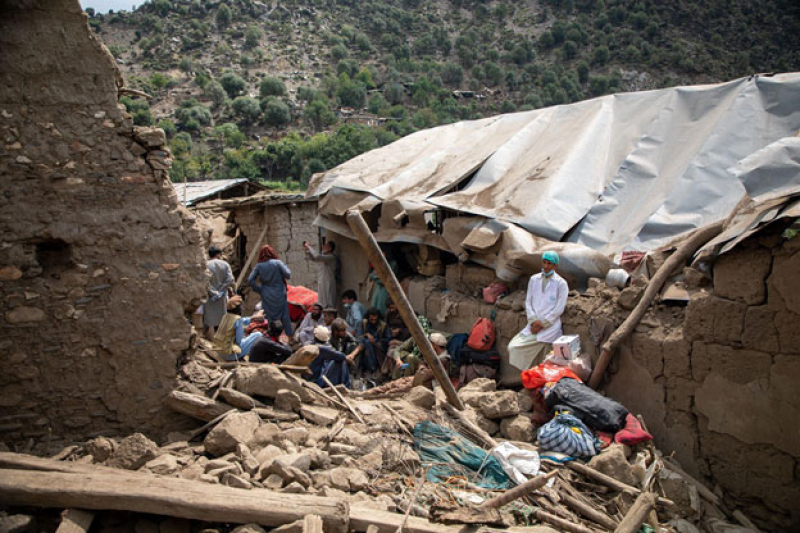- Dhaka breaths ‘very unhealthy’ air Wednesday morning |
- Referendum Ordinance, 2025 issued |
- Chemical fertilizer overuse threatens soil health in northern BD |
- C.A. Yunus expresses concern, sympathy over Korail slum fire |
- UNAIDS Warns of Deepest HIV Response Setback in Decades |
Afghanistan Quake Deepens Humanitarian Catastrophe

A powerful 6.0-magnitude earthquake struck eastern Afghanistan late on 31 August 2025, with its epicenter near Jalalabad in Nangarhar province. Early reports indicate a significant loss of life, including many children, with hundreds of fatalities and thousands injured, alongside widespread destruction of homes and infrastructure.
Afghanistan’s humanitarian situation has deteriorated significantly following the 31 August earthquake, which measured over 6.0 in magnitude and caused immense loss of life and widespread destruction of critical infrastructure.
Compounded by the fragile economy, severe shortages of essential resources, and persistent access challenges, humanitarian organisations are finding it increasingly difficult to reach vulnerable communities—especially women and children.
On 9 September, the United Nations launched a four-month emergency response plan worth USD 139.6 million to support roughly 457,000 people struggling in the aftermath of the earthquake. The plan prioritises high-elevation communities, women, children, and people with disabilities. The International Rescue Committee also announced a response plan for Nangarhar and Laghman provinces, aiming to distribute cash assistance and essential items such as dignity kits.
“The Afghanistan earthquake has caused massive devastation. Hundreds of thousands in remote areas already scarred by conflict and displacement have lost their homes and livelihoods,” said UN Under-Secretary-General for Humanitarian Affairs Tom Fletcher. “Communities hit include those where people returning from Iran and Pakistan had only just begun to rebuild their lives.”
Even before the earthquake, Afghanistan was already facing a multifaceted humanitarian crisis marked by poverty, restrictions on women’s autonomy, and one of the lowest civic space conditions in the world. According to OCHA, 22.9 million Afghans—nearly half the population—urgently required humanitarian assistance prior to the disaster.
As of 7 September, about 500,000 people across Kunar, Laghman, and Nangarhar provinces have been directly affected, with more than 2,200 civilian deaths, 3,600 injuries, and over 6,700 homes destroyed or damaged. Many families lost food stocks and are now living in open, makeshift shelters, exposed to the elements.
OCHA warns that millions face limited access to essential services, as sanitation, healthcare, water, food, and education facilities have been severely damaged. The UNDP reported that 68 major water sources were destroyed, leaving thousands without clean water. OCHA also warned of imminent outbreaks of infectious diseases such as cholera, with 92 percent of displaced civilians in open shelters practising open defecation.
The hunger crisis has further escalated. The World Food Programme reported that nearly 10 million people are facing acute food insecurity, with child malnutrition at “record levels.” Roughly one in three children suffers from stunted development and urgently requires medical intervention. WFP projects that about 15 million people will need lifesaving food aid in the coming months, as winter is expected to worsen health risks and limit access.
Women and girls remain the most vulnerable. UNFPA estimates that around 11,600 pregnant women have been directly impacted, while thousands lack access to feminine hygiene supplies. Afghanistan continues to face one of the highest maternal mortality rates in Asia.
“For pregnant women, a natural disaster can turn an already difficult time into a life-threatening crisis,” said UNFPA’s Kwabena Asante-Ntiamoah. UN Women’s Susan Ferguson added that women humanitarians are “vital to overcome barriers” in providing assistance, stressing the need for women-to-women support in restrictive contexts.
Access to remote, high-elevation communities remains severely limited, with landslides and rockfalls cutting off critical roads. “Even before the earthquake, these villages were difficult to reach,” said OCHA’s Shannon O’Hara. “Now it takes extraordinary effort to get there.”
Funding shortfalls threaten to undermine relief efforts. WFP’s John Aylieff warned that existing funds will only feed earthquake victims for a few weeks. UNHAS helicopter support, critical for reaching remote areas, has been suspended pending new funding.
“This week is a tragic testimony to the devastating impact of aid cuts on one of the world’s most disaster-prone countries,” said Ibrahim. “The international community must step up now to address Afghanistan’s escalating needs.”
The UN’s emergency response plan includes shelter, clean water, food, protection, education, and agricultural support. Relief efforts have already begun, with hot meals, tents, clothing, and blankets delivered to affected communities. Safe spaces for women and children are also being established.
“With winter fast approaching, we are in a race against time to support affected communities with just the bare minimum,” said UN Humanitarian Coordinator Indrika Ratwatte. “The resilience of the Afghan people has been continually tested, but with each crisis there is real danger of reversing fragile gains.”

